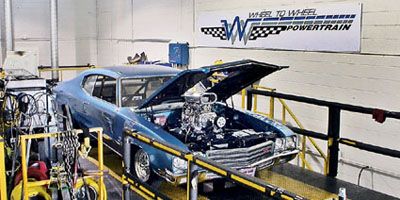
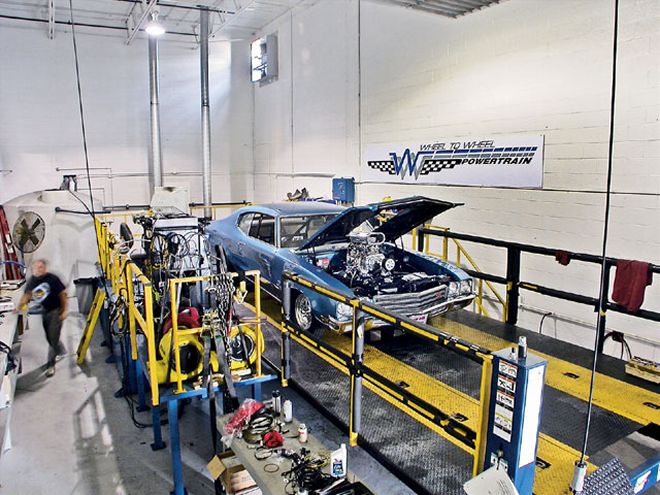 The modern chassis dyno cell, like this Wheel to Wheel Powertrain (W2W) four-wheel-drive Mustang dyno cell, is designed to provide repeatable testing for every type of vehicle up to big horsepower race cars.
The modern chassis dyno cell, like this Wheel to Wheel Powertrain (W2W) four-wheel-drive Mustang dyno cell, is designed to provide repeatable testing for every type of vehicle up to big horsepower race cars.
'While you might consider buying testing time on a vehicle chassis dyno an expensive luxury, we hope you'll at least read this article to consider the possibilities. If anything, what we experienced in creating this story wasn't what we expected, but the safety, durability, and performance unleashed would have definitely been more painful to discover and resolve without time on the chassis rolls. To learn the most we could possibly learn, we partnered with the pros at Wheel to Wheel Powertrain (W2W), in Madison Heights, Michigan, as we ran a vehicle through its paces on the company's four-wheel-drive Mustang chassis dyno.
The Setup
So we dug up a pretty common vehicle for Car Craft: a barely streetable, cool-to-look-at-and-see-driving, somewhat-fast-at-the-dragstrip and seemingly ready to go faster with a little tuning street/strip machine. This '71 Buick Skylark GS Stage 1 killer is replete with a Dyer's 6-71 wheezer adding to the street cred of this 468ci all-Buford ride. Owner Mike Kunkle bought the car mostly complete about a decade ago and has been tuning on it ever since with the idea of getting into the 10-second club in the quarter-mile.
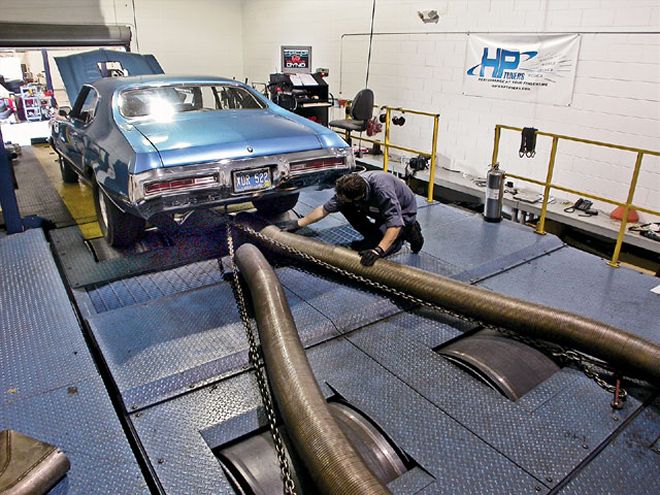 Since vehicles spew serious amounts of exhaust during the wide-open-throttle (WOT) testing, W2W uses an evacuation exhaust system that consists of large fans sucking air through these oversized metal hoses and out through the roof.
Since vehicles spew serious amounts of exhaust during the wide-open-throttle (WOT) testing, W2W uses an evacuation exhaust system that consists of large fans sucking air through these oversized metal hoses and out through the roof.
He has always felt the engine made enough power to go 10s but has never had the engine or vehicle on a dyno. Previous runs at the dragstrip have resulted in tire-smoking elapsed times in the 12s, with trap speeds in the 108-mph range, and after the dyno tune, the car went 11.55 at 114 mph.
The issues this car was faced with were not unusual on the street, making it a good starting point for going to the chassis dyno. The goal was to find out if there were any simple fixes/upgrades that would result in "found" power and improve the chances of a more impressive e.t. Some unexpected finds helped minimize the chances of burning the car to the ground and inadvertently breaking parts, so we'll add that in hindsight-and you should, too-when you test at the chassis dyno.
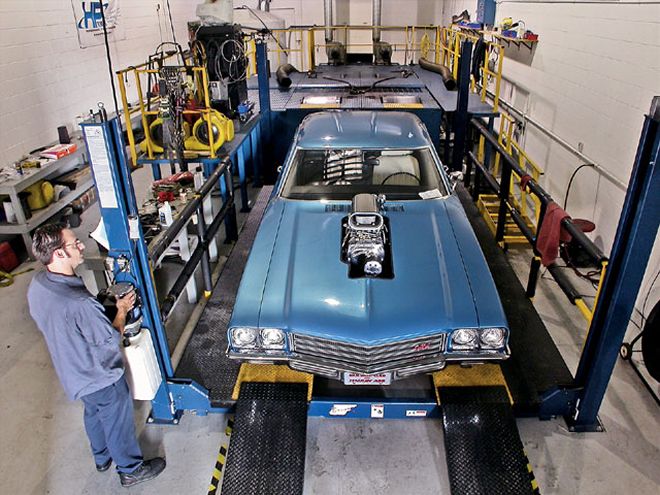 The process of mounting a vehicle onto a chassis dyno differs based on whether the dyno is installed in the floor or above ground (as the W2W dyno is). On an above-ground dyno, the vehicle is pulled onto a lift, as it being performed here, and raised up to the dyno floor.
The process of mounting a vehicle onto a chassis dyno differs based on whether the dyno is installed in the floor or above ground (as the W2W dyno is). On an above-ground dyno, the vehicle is pulled onto a lift, as it being performed here, and raised up to the dyno floor.
The Experience
If you haven't seen a chassis dyno in action, here's the deal. There is a lot of setup time, the actual testing is brief but exciting, and the resulting power numbers are usually numbing-but not in a good way. Invariably, enthusiasts think their vehicles make much more power at the wheels than they really do. In fact, as far as we're concerned, there should be a special private room in which to share the power numbers for the first time-as this is usually gut-wrenching.
The testing with this Buick wasn't unusual in any of those respects. W2W dyno operator Rich Gala drove the vehicle onto the chassis dyno and positioned it so the rear wheels were over one set of the dyno rollers (this is a four-wheel-drive dyno, so in this case, only one set of rollers was used). Large straps were used to lock the vehicle down onto these rollers, and powerful fans directed at the radiator and under the vehicle kept everything cool during the runs.
The W2W dyno can record air/fuel ratio O2 sensor data during a run, but this vehicle did not have an O2 sensor bung in the headers. To assist in the tuning, Denny Dera from the W2W fab shop installed a bung in the passenger header. This would prove to be valuable later on.
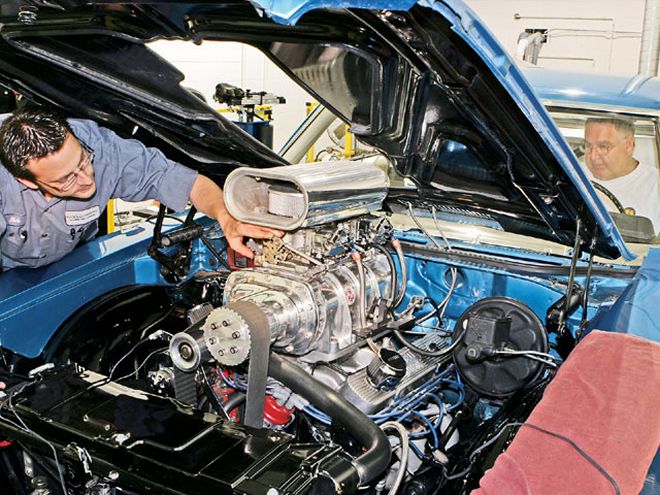 As Gala put it, "I always make a baseline run without looking at anything as long as the timing is safe, then immediately check that the throttle blades are opening 100 percent. I've had some great finds. On a recent 450hp vehicle test, we gained 30 hp by getting the throttle fully open. I usually find single-digit horsepower with this one check." In this case, Kunkle had addressed the issue the previous year, and the throttle blades were opening 100 percent.
As Gala put it, "I always make a baseline run without looking at anything as long as the timing is safe, then immediately check that the throttle blades are opening 100 percent. I've had some great finds. On a recent 450hp vehicle test, we gained 30 hp by getting the throttle fully open. I usually find single-digit horsepower with this one check." In this case, Kunkle had addressed the issue the previous year, and the throttle blades were opening 100 percent.
The Findings
Check out the photos and sidebars to see how the testing went and what you can learn from our pain. Without a doubt, the chassis dyno testing discoveries were more than just horsepower-the car is much safer and consistent. Now, the car should be able to make some laps at the dragstrip with the focus being on getting the car to hook at the line and using all the power it is making.
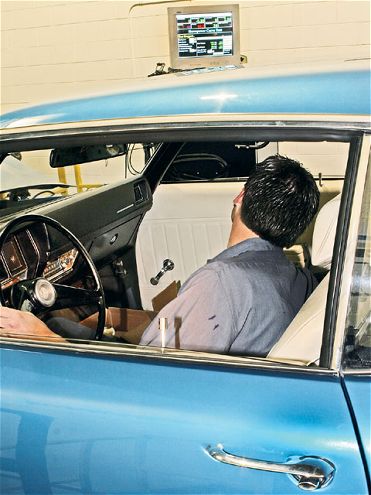 With the vehicle strapped down, Gala "drives" it on the dyno to get everything up to temperature and then makes a few baseline runs to generate initial horsepower and torque results.
With the vehicle strapped down, Gala "drives" it on the dyno to get everything up to temperature and then makes a few baseline runs to generate initial horsepower and torque results.
Kunkle is planning a new engine to produce the 600 rear-wheel horsepower W2W says he'll need to run in the 10s. He's a believer in chassis dynos and looks forward to coming back to the dyno rolls with his new engine installed to debug it before heading out to the dragstrip.
Chassis Dyno Testing Results
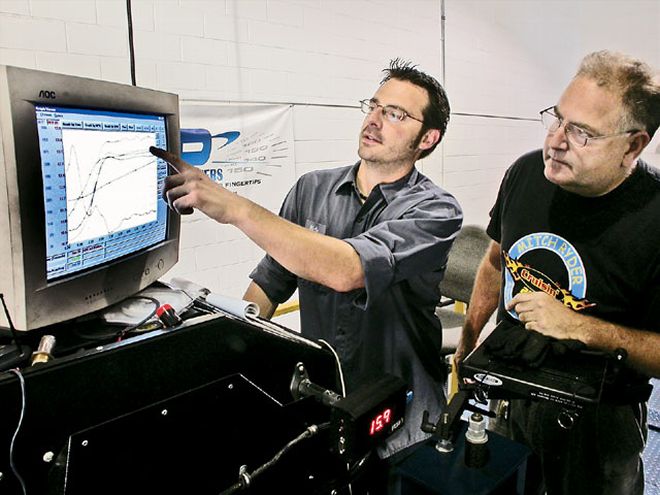 OK, so this is the brutal part. Just about every enthusiast believes his vehicle makes more power than it really does. Before going to the dyno, prepare yourself for the reality and try to focus on just making solid improvements in power, reliability, and durability.
OK, so this is the brutal part. Just about every enthusiast believes his vehicle makes more power than it really does. Before going to the dyno, prepare yourself for the reality and try to focus on just making solid improvements in power, reliability, and durability.
The chassis dyno is a brutally honest piece of equipment, but it tells you much more than just power output. If a vehicle is unsafe or unreliable, the dyno will expose it. We ran into multiple issues that needed to be resolved, and the vehicle is better for having corrected them. They are listed along with the power improvements because of their value to the overall performance of the vehicle.
TEST STEP RESULTS DIFFERENCE Performed baseline testing 320 hp n/a Checked throttle travel at WOT 320 hp 0 hp, but peace of mind Checked timing 326 hp +6 hp, set to 35 BTDC Tuned carb setup 326 hp 0 hp, but smoother idle Fixed vacuum/pressure leaks 350 hp +25 hp, blown-out gasket Fixed underhood oil leak 350 hp 0 hp, minimized fire hazard Fixed leaking transmission pan 350 hp 0 hp, durability improvement Fixed slipping blower-belt tensioner 350 hp 0 hp, improved reliability Repaired blown transmission 370 hp +20 hp, replaced torque